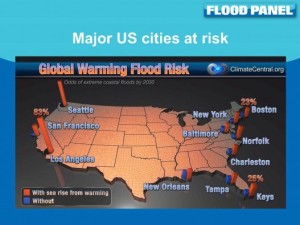By Tom Osborne, President Flood Panel LLC
Sea levels are rising at an alarming rate. According to a report in Nature Communications, sea levels on the northeast coast of the U.S. made a dramatic jump in the year 2009-2010. At first glance, the increase of about 128mm (4″) does not seem to be particularly noteworthy. Statistically, however, the sudden increase is very significant. This single-year rise has not been seen at any time during the last 100 years, and is said to be an event that occurs no more than once every 850 years.
Rising sea levels are of critical importance to the millions of residents and business owners that throng this highly-developed region. Any increase in sea level means that storm surges have an ever-increasing toehold on the land where homes, businesses and skyscrapers cling to precarious foundations. The evidence is now almost universally accepted by scientists: climate change is largely responsible for the increase in sea levels.
Sea level rise is affected by many factors. The northeast coast of the U.S. is close to ocean currents that are very strong, fierce and damaging. Ocean currents, changes in wind patterns, the increasing incidence of storms and hurricanes, climate change and global sea level rise combine in ways not fully understood. These factors influence each other and may produce conditions not yet seen or studied. For this reason, a jump in sea level rise could cause far-reaching results that seem grossly out of proportion to the 128mm increase.
There are many theories to explain the sudden sea level rise. The most accepted theory blames the Atlantic Ocean current called the Atlantic meridional overturning circulation (AMOC). When the AMOC slows, weather patterns, erosion patterns and sea levels are affected on both sides of the Atlantic. Scientists predict that the AMOC will continue to slow during this century, increasing the rate of sea level rise for the northeast U.S. coastal regions.
The situation may be worse than predicted by scientists, and must therefore be addressed on a timeline more aggressive than is currently in place.
The New York City Panel on Climate Change earlier this year released a report that foresees a sea level rise of six feet for the New York area during this century. Sea level rise in this zone is already about twice the global average, and much of the metropolis is low lying. FEMA flood maps show how much of the city is at risk for flooding.
The dire prediction inspired quick action by New York Mayor Bill DeBlasio. The mayor announced plans to reduce emissions in New York City by an ambitious 80 percent and unveiled measures that will be put in place to protect his vulnerable city from flooding. “We have a comprehensive, multi-layered resiliency plan that is already making neighborhoods safer,” DeBlasio said.
The city is also investing $30 million in innovative technologies and climate change solutions to at-risk and vulnerable small businesses impacted by Hurricane Sandy. Among the building systems that will be deployed by the city are thin, impact-resistant, modular flood barriers that can be installed quickly and efficiently before a storm event; technology that monitors flood control data in real time to control valves in storm and plumbing systems, preventing critical utility systems from flood inundation; and a system to capture, transfer and deliver natural light to dark interior building spaces. (Click to read the news release).
These actions by New York City are prudent and timely with tropical storms already impacting the east coast before the official start of the Atlantic hurricane season on June 1. Property owners located in coastal zones will need to take prompt action to protect investments and lives. Practical and comprehensive measures should be implemented to defend against the encroaching sea.
###
Tom Osborne is the president of Flood Panel, LLC of Jupiter, Florida (www.floodpanel.com), where he oversees design, development and operations for the manufacture of flood mitigation products for commercial buildings in flood zones nationwide. Tom has worked closely with the Association of Flood Plain Managers nationwide, and specifically in New Jersey, where recovery from major flooding caused by Hurricane Sandy is ongoing. Tom is a member of the Small Business Association of America and is a Certified Provider of Continuing Education for the Architectural Institute of America for Dry Flood Proofing Commercial Buildings.
Source:: http://www.floodbarrierusa.com/








